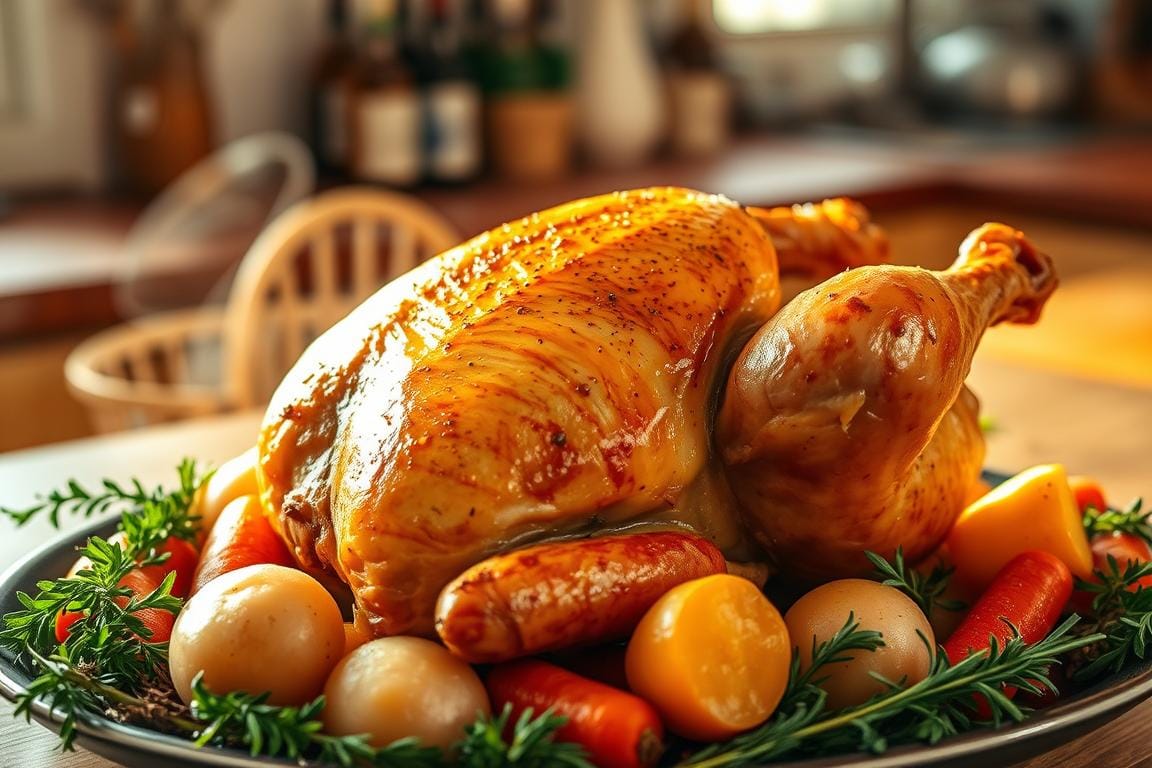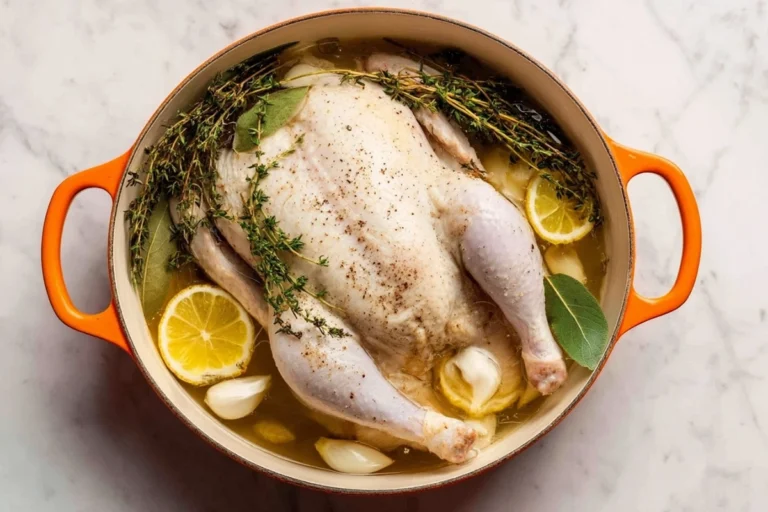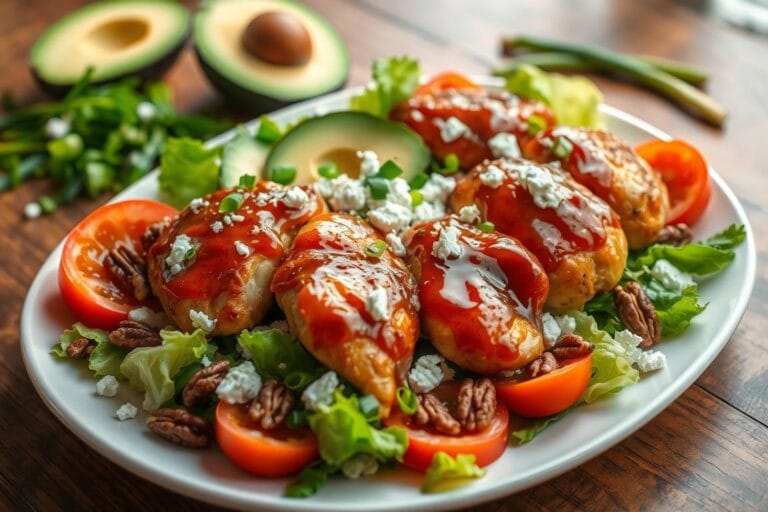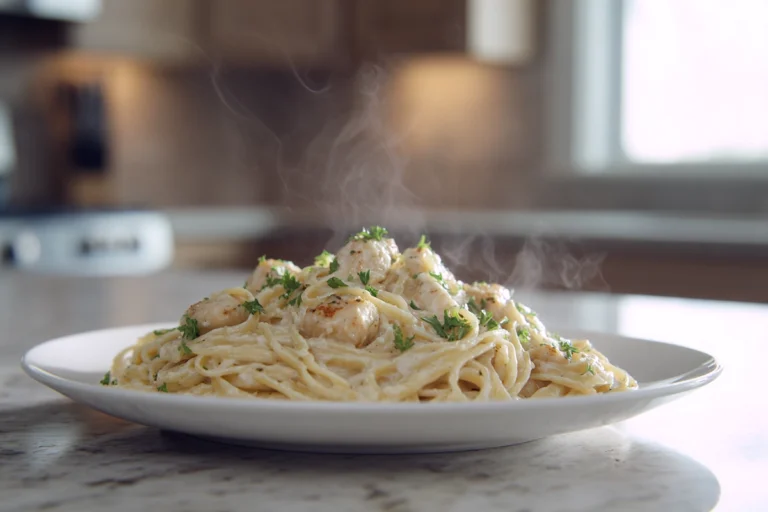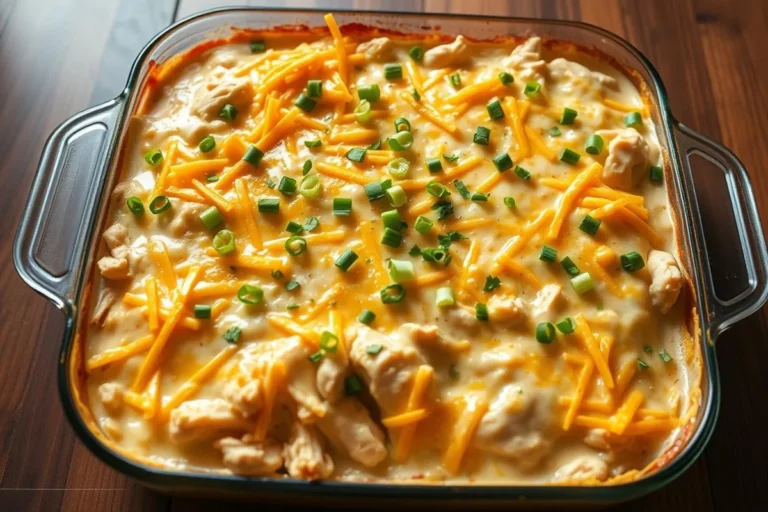Delicious Oven Roasted Chicken: Juicy & Flavorful
Imagine sinking your teeth into a perfectly cooked chicken with crispy skin and juicy meat. It’s a culinary delight that’s simple to achieve and impressive to serve.
A perfectly roasted chicken is more than just a meal; it’s a versatile centerpiece for any occasion, from a weeknight dinner to a special gathering. With just a few ingredients and some basic cooking techniques, you can create a dish that’s both flavorful and memorable.
Mastering the art of roast chicken opens up a world of meal possibilities, from satisfying your family’s dinner needs to preparing a stunning main course for guests. In this article, we’ll guide you through creating a deliciously juicy roast chicken that will become a staple in your kitchen.
Key Takeaways
- Master a flavorful yet straightforward roast chicken recipe
- Learn the benefits of cooking a whole chicken
- Discover how to achieve crispy skin and juicy meat
- Explore the versatility of roast chicken for meal prep and special occasions
- Understand the economic benefits of cooking a whole chicken
The Perfect Oven-Roasted Chicken
Roasting a chicken in the oven can result in a juicy and full-flavored dish. This straightforward cooking method yields consistently impressive results, making it a staple in many kitchens.
The beauty of oven-roasted chicken lies in its simplicity and the minimal ingredients required. You don’t need to stuff the cavity with aromatics or place the chicken on a bed of vegetables, although you can if you prefer. The key to a perfect roast chicken is the preparation and the cooking technique.
Why Roast Chicken Is a Kitchen Staple
Roast chicken is a fundamental dish in many cuisines around the world. It’s a comfort food that evokes a sense of home and warmth. The reasons for its popularity are numerous:
- It’s a relatively simple dish to prepare, requiring minimal ingredients.
- It’s versatile, allowing for various seasonings and marinades.
- It’s a healthy option when cooked without excessive oil.
- It can be served in numerous ways, from a straightforward family dinner to a more elaborate meal with sides and gravy.
This versatility and simplicity make roast chicken a staple in many kitchens, suitable for beginners and experienced cooks.
What Makes This Recipe Special
This oven-roasted chicken recipe stands out because it emphasizes enhancing the chicken’s natural flavor while ensuring the skin is crispy and the meat remains juicy. The techniques used are designed to be easy to follow, making them accessible to anyone looking to achieve a delicious roast chicken.
The recipe balances simplicity with maximum flavor, using a minimal ingredient list that delivers exceptional results. It’s flexible, allowing you to accommodate personal preferences while maintaining the core techniques that ensure a successful outcome.
Ingredients You’ll Need
The key to a delicious oven-roasted chicken is selecting the freshest and most appropriate ingredients. The quality of your ingredients directly impacts your dish’s flavor and overall outcome.
Choosing the Right Chicken
The type and quality of the chicken you choose are crucial when it comes to oven-roasted chicken. Opt for a fresh, plump chicken with no signs of damage or discoloration. Consider the size of your chicken based on the number of people you’re serving and whether you want leftovers.
Essential Seasonings and Aromatics
Basic seasonings such as salt, pepper, and herbs like thyme and rosemary are staples. They provide a fundamental flavor profile that complements the chicken. Don’t forget aromatics like onion, celery, and lemon, which you can stuff into the cavity for added depth of flavor.
Optional Flavor Enhancers
To elevate your oven-roasted chicken, consider incorporating optional ingredients. Melted butter can be used for basting, while ingredients like garlic powder and fresh rosemary add extra layers of flavor. You can also experiment with compound butters or different herbs and spices to create unique flavor profiles.
| Ingredient | Purpose | Example |
|---|---|---|
| Aromatics | Stuff into cavity for added flavor | Lemon, onion, celery, thyme |
| Herbs and Spices | Season the chicken for flavor | Salt, pepper, garlic powder, rosemary |
| Butter | Baste the chicken for moisture and flavor | Melted butter |
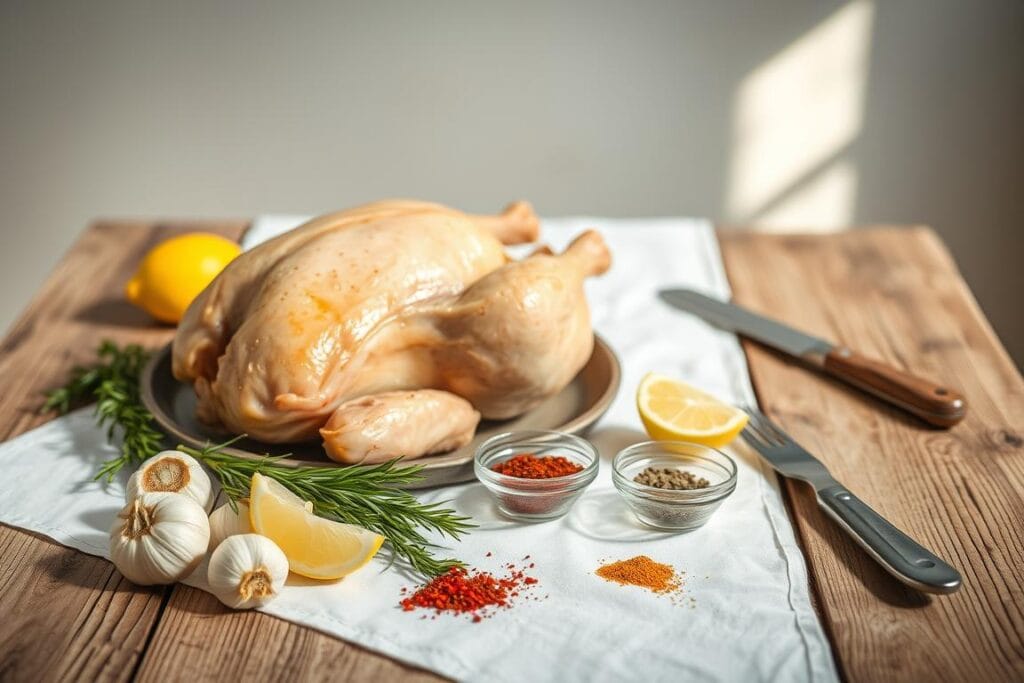
Equipment for Roasting Success
Roasting a chicken to perfection requires more than just a good recipe; it demands the right equipment. Having the proper tools can significantly impact the outcome of your dish, making the cooking process smoother and more efficient.
Roasting Pans and Alternatives
The choice of roasting pan can affect the roasting process. A heavy-duty roasting pan is ideal as it distributes heat evenly. If you don’t have one, alternatives like a cast-iron skillet or a heavy baking dish can work well. The key is to use a pan that can withstand high oven temperatures.
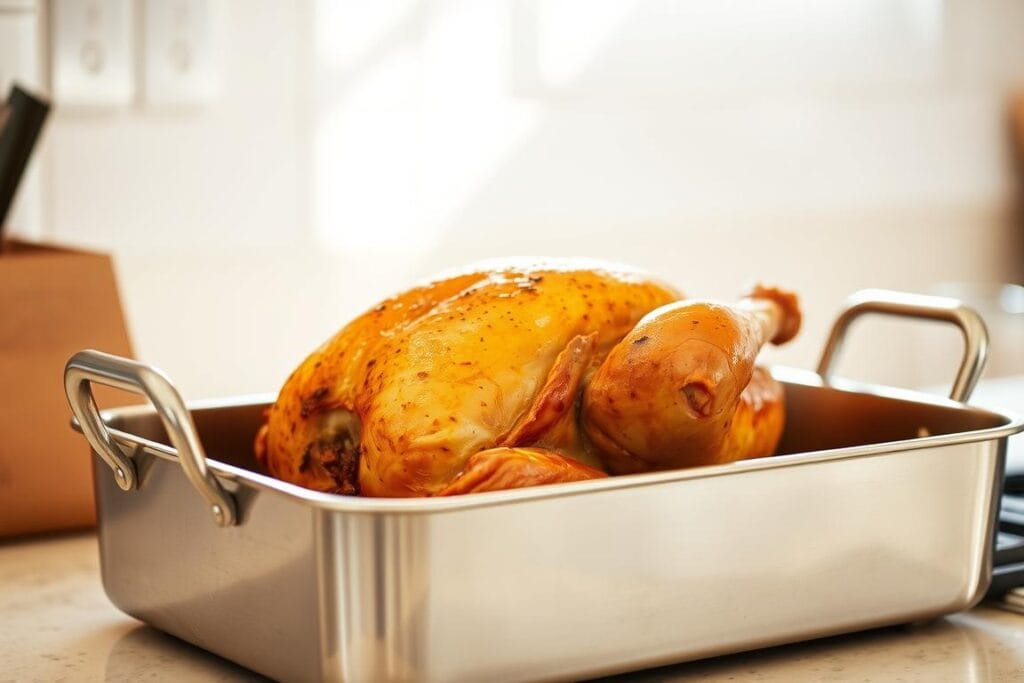
Useful Tools and Gadgets
Several tools can enhance your roasting experience. A meat thermometer ensures your chicken is cooked to a safe internal temperature of 165°F (74°C). Kitchen twine is useful for trussing the chicken, promoting even cooking. Other helpful tools include kitchen shears for trimming excess fat, basting tools like brushes or bulb basters, and carving tools such as a sharp knife and sturdy fork.
- A reliable meat thermometer ensures food safety and perfect doneness.
- Kitchen twine helps achieve even cooking by trussing the chicken.
- Kitchen shears help trim excess fat and cut through joints when carving.
- Basting tools apply butter or pan juices during cooking, enhancing flavor.
- Carving tools, including a sharp knife and sturdy fork, enable clean, efficient slicing.
Preparing Your Chicken
Proper preparation is vital to ensure your oven-roasted chicken is juicy and flavorful. This involves several key steps that help enhance the chicken’s natural flavors and achieve a crispy, golden-brown exterior.
Cleaning and Patting Dry
The first step in preparing your chicken is to clean it under cold water, removing any giblets or neck from the cavity. After rinsing, gently pat the chicken dry with paper towels inside and out. This crucial step helps to remove excess moisture, allowing the seasonings to adhere better and the skin to crisp up during roasting.
Trussing Techniques
Trussing your chicken can help it cook more evenly and prevent the legs from burning. To truss, use kitchen twine to tie the legs together at the ankles. You can’t tuck the wings under the body to promote even browning and prevent them from getting in the way. While trussing is optional, it can contribute to a neater, more evenly cooked final product.
Seasoning Methods

Seasoning is where you can get creative with your oven-roasted chicken. Start by liberally applying salt both inside and outside the chicken. Please don’t be shy with the salt, as it helps to crisp the skin and enhance the overall flavor. Next, evenly rub the chicken with oil, making sure to coat all surfaces, including underneath the chicken. You can also add your choice of herbs and spices to the cavity and under the skin for added depth of flavor.
When it comes to seasoning, you can season immediately before cooking or dry-brine the chicken a few hours ahead. Dry brining involves rubbing the chicken with salt and letting it sit in the refrigerator for a few hours to allow the salt to penetrate the meat. This can result in a more complex, developed flavor.
Consider rubbing the chicken with butter or oil to incorporate fat into your seasoning. This not only promotes browning but also helps to keep the meat moist. By following these seasoning methods, you can achieve a deliciously flavored oven-roasted chicken that’s sure to impress.
The Perfect Roasting Method
To roast a juicy and flavorful chicken, you need to master a few crucial techniques. The process involves more than just placing the chicken in the oven; it requires attention to temperature, cooking time, and the resting period.
Temperature Settings
Preheating your oven to the right temperature is crucial. For roasting chicken, a temperature of 425°F (220°C) is often recommended as it allows for a nice skin browning while cooking the meat evenly.
Cooking Times Based on Weight
Cooking time is mainly dependent on the weight of the chicken. A general rule of thumb is to roast the chicken for about 20 minutes per pound. For example, a 4-pound chicken would take around 80 minutes to cook. However, this can vary depending on your oven and the chicken’s preparation.
It’s also important to consider that stuffing or trussing the chicken can affect cooking time. Always check the chicken periodically to avoid overcooking.
How to Tell When Your Chicken Is Done
Ensuring your chicken is cooked thoroughly is vital for food safety. The most reliable method is to check the internal temperature, which should reach 165°F (74°C) in the thickest part of the breast and 180°F (82°C) in the thigh. You can also check by cutting into the thickest part of the thigh; the juices should run clear.
The Importance of Resting
Letting the chicken rest for 15 minutes on a cutting board before slicing is crucial. This resting period allows the juices to redistribute throughout the meat, making it more tender and juicy. To rest the chicken, tent it loosely with foil to keep it warm. Skipping this step can result in the juices running out, leaving the meat dry.
You can prepare side dishes or make gravy from the drippings during this time. Cut into it gently to check if the chicken has rested enough; if the juices no longer run freely, it’s ready to be carved.
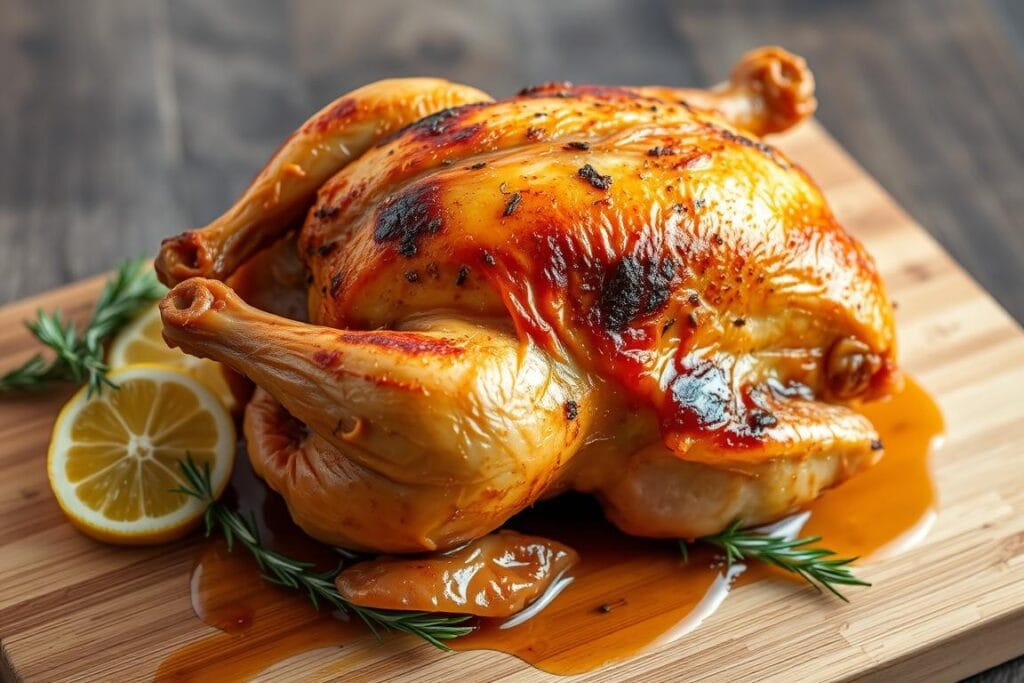
Tips for Juicy and Flavorful Results
Unlock the full potential of your oven-roasted chicken by incorporating these tried-and-true methods for enhancing flavor and retaining moisture. A perfectly roasted chicken is not just about following a recipe; it’s about understanding the techniques that make a real difference.
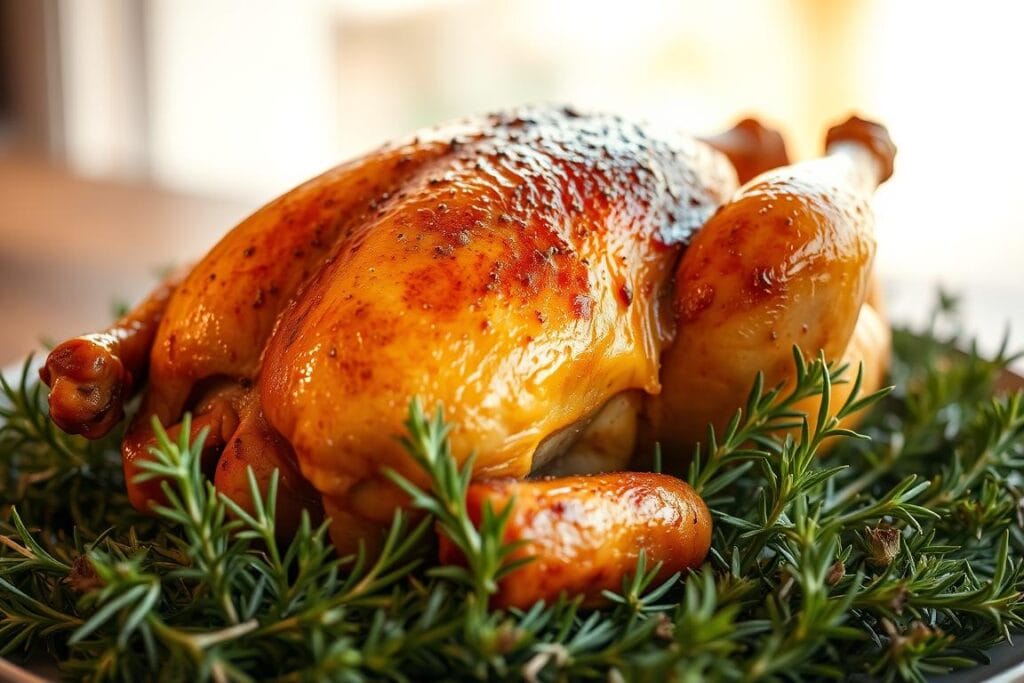
Achieving Crispy Skin
Crispy skin is a hallmark of a well-roasted chicken. To achieve this, start by patting the skin dry before seasoning. This helps to remove excess moisture, allowing the skin to crisp up during cooking. Another technique is to initially roast the chicken at a higher temperature, then reduce the heat to finish cooking. This initial blast of heat helps to crisp the skin.
You can also rub the skin with a mixture of salt, pepper, herbs, and spices to enhance the flavor. For an extra crispy texture, consider broiling the chicken for a few minutes after roasting, keeping a close eye to prevent burning.
Keeping the Meat Moist
It’s essential not to overcook the chicken to keep the meat moist. A meat thermometer ensures the internal temperature reaches a safe 165°F (74°C). Another method is to baste the chicken with pan juices every 20-30 minutes during cooking. This not only keeps the meat moist but also enhances the overall flavor.
Trussing the chicken can also help retain moisture by ensuring it is evenly cooked. Tying the legs together promotes uniform heat distribution around the bird.
Flavor-Boosting Techniques
One of the simplest ways to boost flavor is to use the pan drippings to create a delicious gravy. After removing the chicken from the roasting pan, deglaze the pan with a bit of wine or broth, scraping up any browned bits. This mixture can then be simmered to create a rich, savory gravy that complements the roasted chicken perfectly.
Other techniques include adding aromatic vegetables like onions and carrots to the roasting pan, which infuse the chicken and pan juices with additional flavor. You can also infuse butter with herbs and garlic before applying it under the skin for maximum flavor impact.
Delicious Variations to Try
Transform your roast chicken recipe with these simple yet effective variations. You can create a unique dish that suits your taste preferences by incorporating different ingredients and techniques.
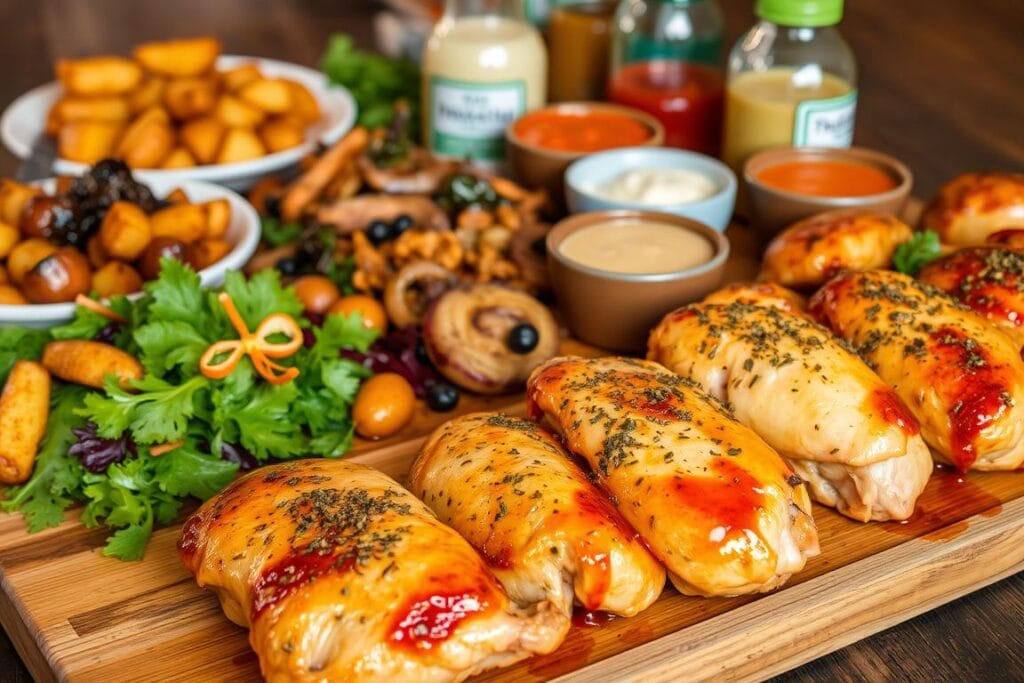
Herb and Citrus Combinations
One way to add flavor to your roast chicken is using herb and citrus combinations. You can stuff the cavity with fresh herbs like thyme, rosemary, and parsley, along with slices of citrus fruits like lemon or orange. For example, you can combine 1/2 a lemon, onion, celery, thyme, and salt to create a delicious and aromatic filling.
This approach adds flavor to the chicken and creates a fragrant aroma that fills your kitchen. You can experiment with different herb and citrus combinations to find the one you enjoy the most.
Spice Rubs and Marinades
Another way to enhance the flavor of your roast chicken is to use spice rubs and marinades. You can create a spice rub using a mixture of spices like paprika, garlic powder, and chili powder, and rub it all over the chicken. Alternatively, you can marinate the chicken in olive oil, lemon juice, and herbs for several hours or overnight.
These techniques help to add depth and complexity to the chicken’s flavor, making it more interesting and delicious. You can experiment with different spice rubs and marinades to find the best one.
Stuffing Ideas
Several options exist for stuffing your roast chicken. You can use aromatics like onion, carrot, and celery to flavor the chicken without cooking stuffing inside. However, you can use bread-based, grain, or vegetable stuffings if you prefer to cook stuffing inside the chicken.
It’s essential to be mindful of the amount of stuffing you use, as overcrowding the cavity can lead to uneven cooking. You can prepare stuffing separately and infuse the chicken with complementary flavors. This approach allows you to achieve the perfect balance of flavors while ensuring food safety.
You can create a unique and delicious roast chicken recipe that suits your taste preferences by trying out these different variations.
Serving Your Oven-Roasted Chicken
Serving your oven-roasted chicken is the final step in creating a memorable dining experience. How you present your dish can elevate the overall enjoyment of the meal.
Classic Side Dishes
Choosing the right side dishes to accompany your roasted chicken can enhance the flavors and textures of the meal. Classic options include roasted vegetables, mashed potatoes, and fresh salads. These sides complement the rich flavors of the chicken without overpowering it.
Consider serving your chicken with gravy over egg noodles or steamed green beans for a more comforting meal. The key is to balance the meal with various flavors and textures.
Carving Techniques
Carving your roasted chicken properly is essential for a visually appealing presentation. Start by removing the legs, then separate the thighs from the drumsticks. Use a sharp knife and a stable cutting surface to make clean cuts.
To carve the breast, slice it against the grain to preserve juiciness. You can serve the chicken family-style or plate it individually for a more formal arrangement. For more extended storage, consider carving the chicken into individual pieces, such as breasts, legs, and wings, and freezing them in a sealed container for up to 3 months.
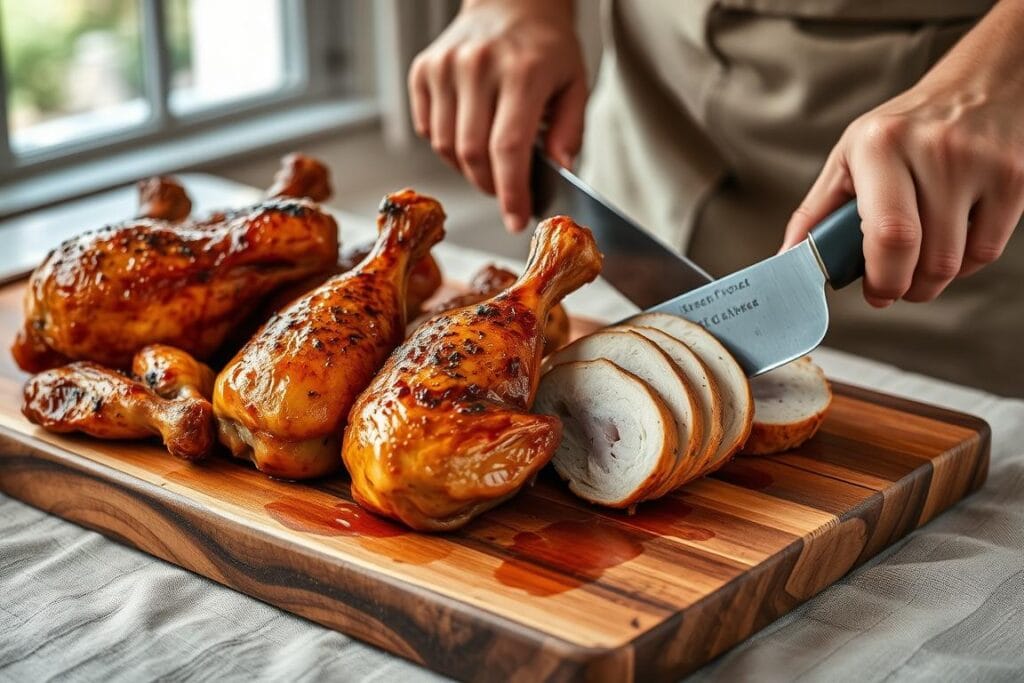
Making the Most of Leftovers
With a bit of creativity, leftover roasted chicken can become the star of a new meal. You can transform it into various dishes, from soups and salads to sandwiches and casseroles, ensuring you get the most out of your protein-packed leftover chicken.
Storage Tips
Before trying new recipes, it’s essential to store leftover roasted chicken properly. Cool it to room temperature within two hours of cooking, then refrigerate or freeze it. Use airtight containers to keep it fresh for up to three to four days in the fridge or up to four months in the freezer.
Creative Leftover Recipes
Leftover roasted chicken can be repurposed in numerous delicious ways. Here are some ideas to get you started:
- Turn it into a salad: Slice pieces and layer on top of any salad for a protein boost, like a kale salad with apples and chicken.
- Add it to a protein bowl: Start with a rice or leafy greens base, then pile on your favorite veggies, diced roast chicken, pickled onions, or even a dollop of hummus!
- To make a breakfast hash, Dice the potato into cubes and cook it with other seasonal veggies in a pan. Then, crack a few eggs on top for the final touch.
- Add it to a soup: You can make a classic roasted chicken soup or even my white chicken chili with it.
These recipes reduce food waste and provide quick and easy meal solutions for busy weekdays. You can enjoy various meals by getting creative with your leftovers while maximizing your initial cooking effort.
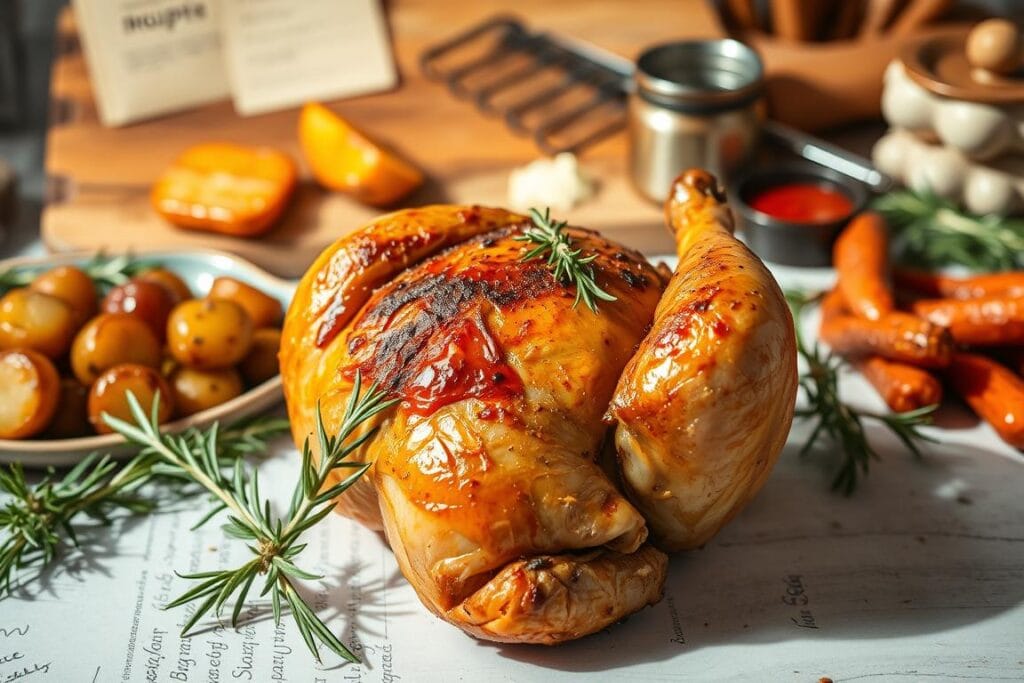
Troubleshooting Common Issues
Achieving a perfectly roasted chicken requires a good recipe and the ability to address any issues that may arise during cooking. Whether you’re dealing with undercooked or overcooked meat or struggling with soggy skin, understanding how to troubleshoot these problems can elevate your roasting game.
Undercooked or Overcooked Chicken
One of the most critical issues when roasting a chicken is ensuring it’s cooked to the right temperature. If your chicken is undercooked, return it to the oven and check its temperature every 10 minutes until it reaches 165°F. On the other hand, if your chicken is overcooked, it’s likely due to incorrect temperature settings or cooking times. Always use a meat thermometer and follow a reliable cooking time guide to avoid this.
Soggy Skin Problems
Skin that’s soggy rather than crispy can be a disappointment. Common causes include insufficient skin drying before roasting, overcrowding in the pan, and cooking at too low a temperature. To rescue soggy skin, you can try brief broiling to crisp it up. For future roasts, pat the chicken dry before seasoning and roast at a high enough temperature to achieve crispy skin. If the skin starts to burn, covering it with aluminum foil for the last 10 minutes can prevent further browning.
| Issue | Cause | Solution |
|---|---|---|
| Soggy Skin | Insufficient drying, overcrowding, low temperature | Pat dry, ensure space, increase temperature |
| Undercooked Chicken | Insufficient cooking time | Return to oven, check temperature every 10 minutes |
| Overcooked Chicken | Incorrect temperature or cooking time | Use a meat thermometer, follow cooking guides |
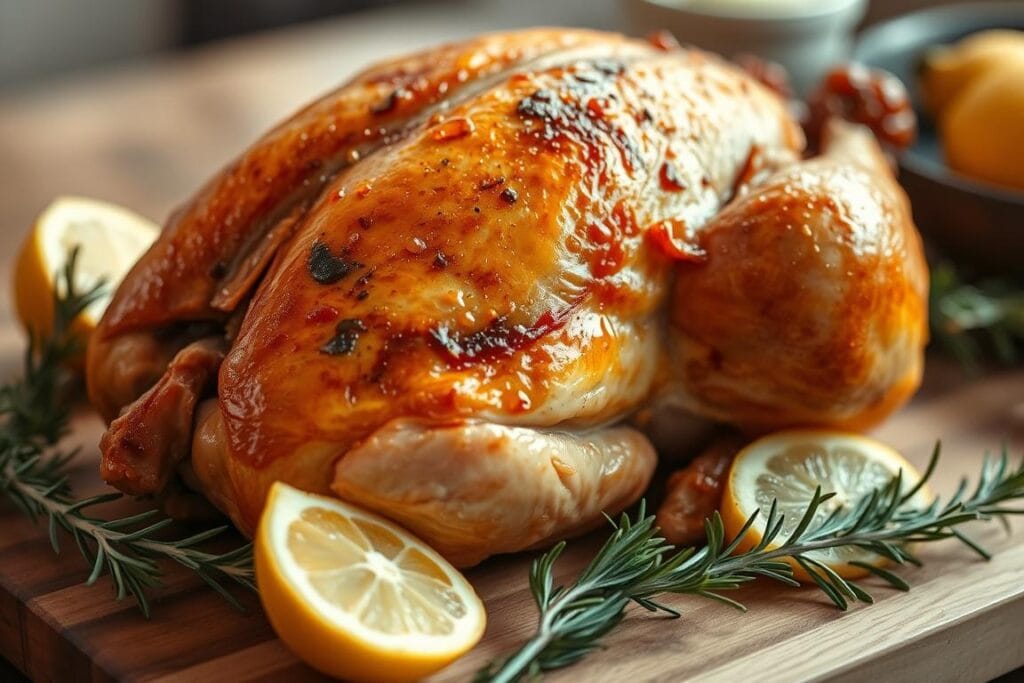
Conclusion
With the techniques and tips outlined in this article, you’ll be on your way to perfectly roasted chicken every time.
By mastering this recipe, you’ll elevate your cooking skills and gain a versatile dish that can be enjoyed on any occasion. Whether you’re cooking for a weeknight dinner or a special event, chicken is sure to be a crowd-pleaser.
Feel free to experiment with different flavors and variations to make the recipe your own. As you continue to roast chicken, you’ll build confidence and develop your signature style in the kitchen. Please share your experiences and favorite variations with us in the comments below!
FAQ
How long does it take to roast a whole chicken in the oven?
The cooking time depends on the weight of your chicken and the temperature setting. As a general guideline, you can roast a whole chicken at 425°F (220°C) for about 45-60 minutes per pound.
What’s the best way to ensure juicy meat and crispy skin?
To achieve juicy meat and crispy skin, make sure to pat the chicken dry before seasoning, and don’t overcrowd the roasting pan. You can also try trussing the legs together with kitchen twine to promote even cooking.
Can I add potatoes and other vegetables to the roasting pan?
Yes, you can add potatoes, carrots, and other root vegetables to the roasting pan with the chicken. Just be sure to adjust the cooking time and temperature as needed to ensure everything is cooked through.
How do I know when the chicken is cooked to a safe internal temperature?
Use a thermometer to check the internal temperature of the chicken. It should reach 165°F (74°C) in the thickest part of the breast and 180°F (82°C) in the thickest part of the thigh.
Can I use different seasonings and herbs to change up the flavor?
Absolutely! You can try using different herbs like thyme and rosemary, or spice rubs to give your chicken a unique flavor. Feel free to experiment with various seasonings and aromatics to find your favorite combination.
How should I store leftovers?
To store leftovers, let the chicken cool completely, then refrigerate or freeze it in airtight containers. You can use leftovers to make mashed potato bowls, chicken salads, or other creative recipes.

Delicious Oven Roasted Chicken: Juicy & Flavorful
- Total Time: 1 hour 45 minutes
- Yield: 6 servings 1x
Description
This oven-roasted chicken is juicy, tender, and flavorful with crispy golden skin. Perfect for both weeknight dinners and special occasions, it’s a simple yet impressive recipe that requires minimal ingredients and delivers outstanding results every time.
Ingredients
Main Ingredients:
1 whole chicken (4–5 lbs), giblets removed
2 tbsp olive oil or melted butter
1 tsp salt
½ tsp black pepper
1 tsp garlic powder
1 tsp paprika (optional)
Fresh rosemary or thyme (optional)
Aromatics (for cavity):
1 lemon, halved
1 onion, quartered
1 stalk celery, cut into chunks
2 garlic cloves
Instructions
Preheat oven to 425°F (220°C).
Prepare the chicken: Rinse and pat dry the chicken thoroughly with paper towels.
Season: Rub the entire chicken with olive oil or butter. Sprinkle salt, pepper, garlic powder, and optional paprika evenly on all sides.
Stuff cavity (optional): Insert lemon, onion, celery, and garlic into the cavity.
Truss legs: Tie legs together with kitchen twine for even cooking (optional).
Roast: Place chicken breast in a roasting pan or cast-iron skillet. Roast for 80–90 minutes (about 20 minutes per pound), or until internal temperature reaches 165°F in the breast and 180°F in the thigh.
Rest: Let chicken rest 15 minutes, tented with foil, before carving.
Serve: Carve and serve with your favorite sides or make gravy with pan drippings.
Notes
For crispier skin, pat the chicken dry and roast uncovered.
Baste every 30 minutes for extra flavor and moisture.
Use leftovers in salads, soups, sandwiches, or casseroles.
Try a spice rub or herb butter under the skin to add variety.
- Prep Time: 15 minutes
- Cook Time: 1 hour 30 minutes
- Category: Main Course
- Method: Roasting
- Cuisine: American
Keywords: oven roasted chicken, whole chicken recipe, crispy chicken skin, juicy roast chicken, easy roast chicken, baked whole chicken, roast dinner
What Are Our Readers Saying?
There are no reviews yet. Be the first one to write one.

